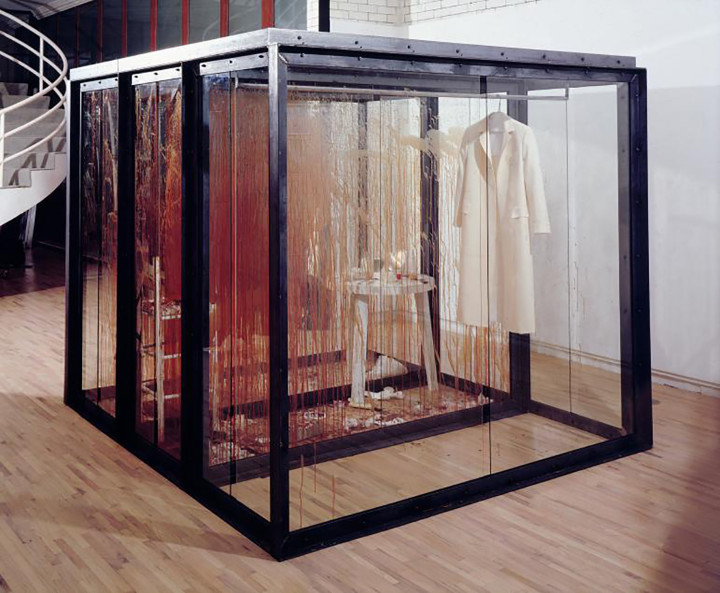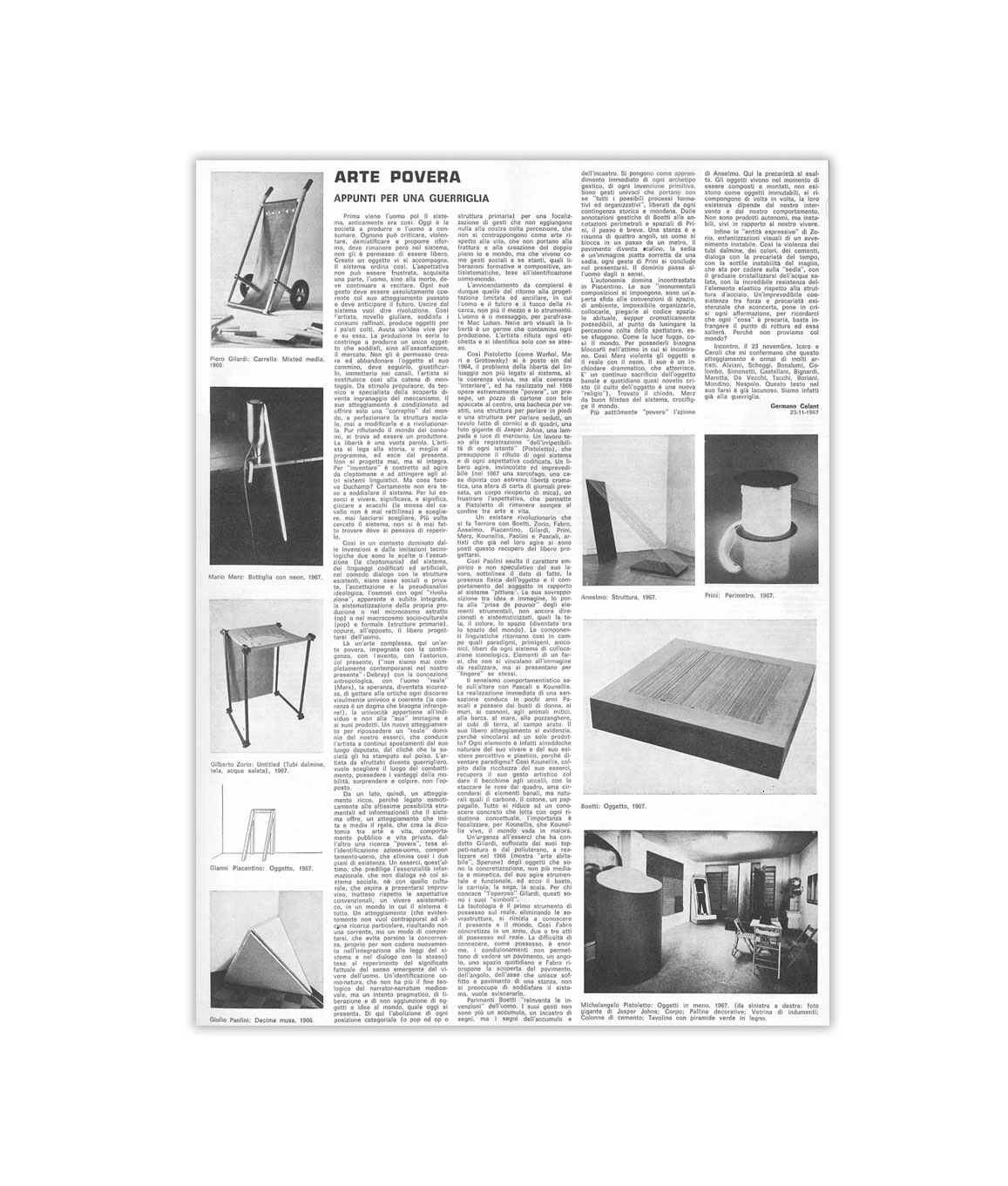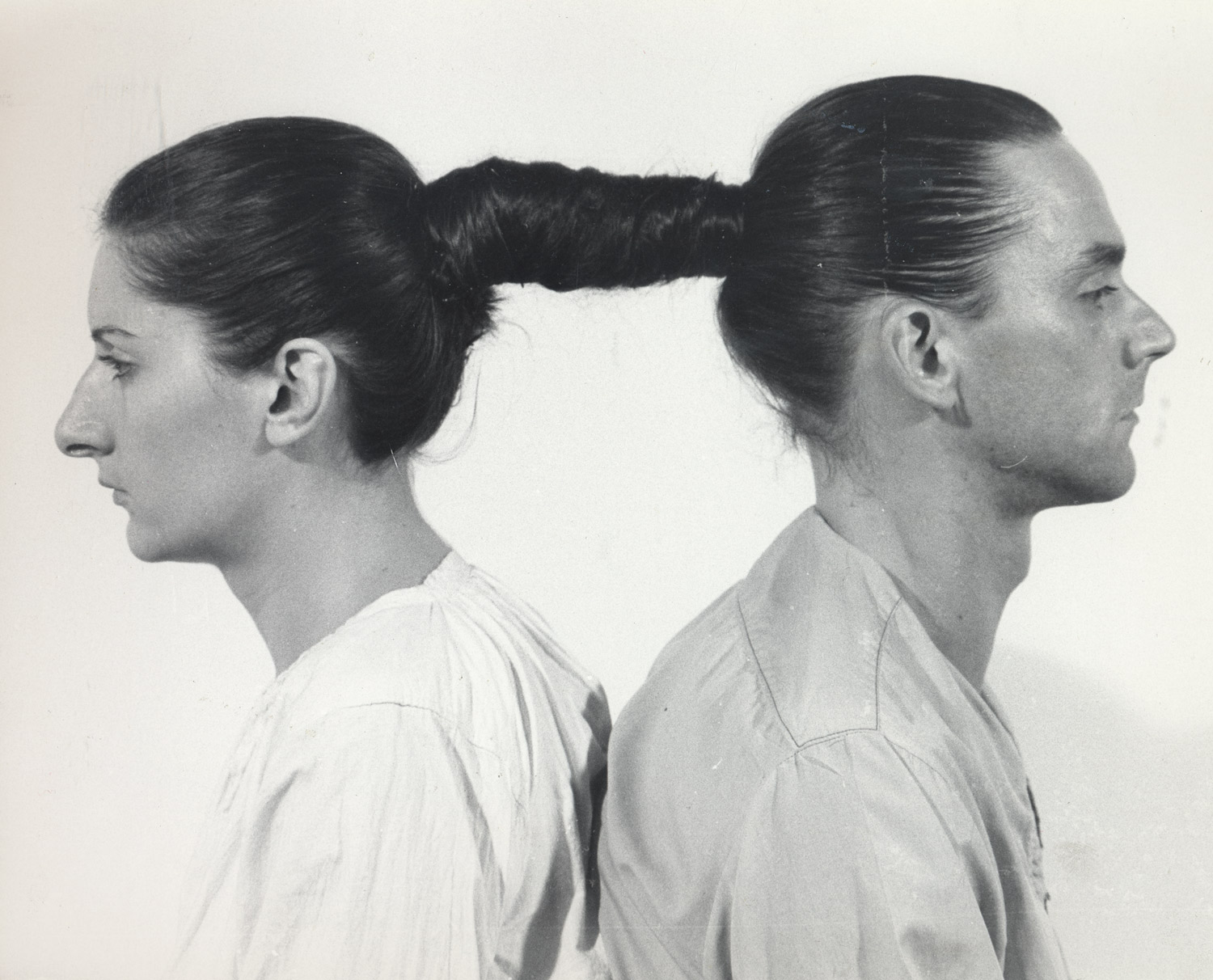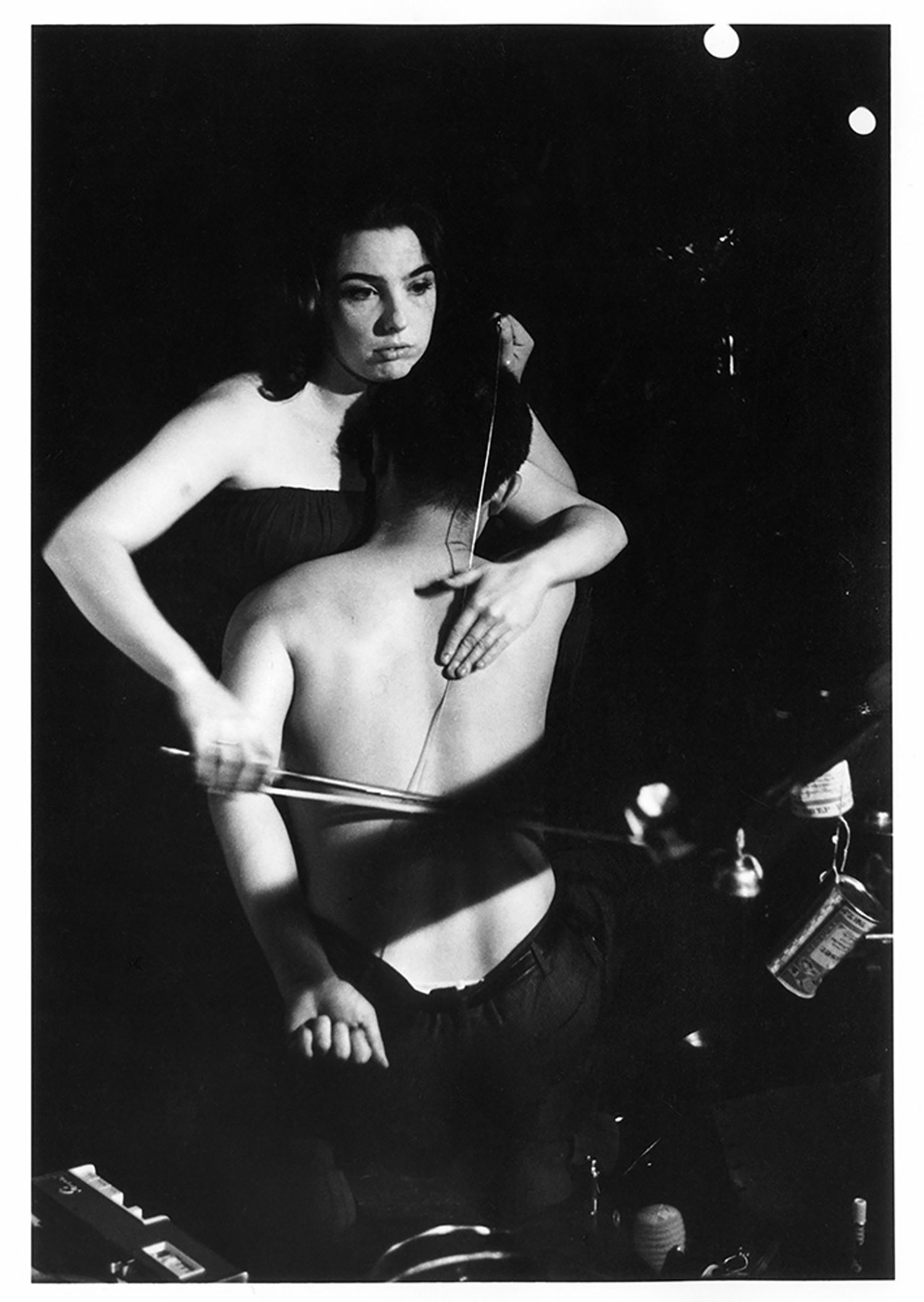
A glass full of bloodstained water in which some little fish are dying / a page of typing torn into twenty-three pieces / a sore of filthy disease in snow white bandages.
(Toni Del Renzio, can you change a shilling)
Adrian Dannatt: Pharmacy, which was shown at the Cohen Gallery in New York in 1992, feels kind of religious. As a viewer, it’s like being inside one of the vitrine pieces.
Damien Hirst: I’ve always seen medicine cabinets as bodies, but also like a cityscape or civilization, with some sort of hierarchy within it. It’s also like a contemporary museum of the Middle Ages. In 100 years time this will look like an old apothecary. A museum of something that’s around today.
AD: In France they have glistening pharmacies meant to be the most up-to-date imaginable, but they already look dated because it’s such a ’70s idea of Modernism.
DH: They provoke an idea of confidence, of trust in minimalism. I love medical logos, so minimal, so clean, there’s something dumb about it. I like the idea of outside and inside. The cabinets could be people and the drugs internal parts, and they relate to different parts of the body.
AD: Is the theme of escape in pieces such as The Acquired Inability to Escape (1991) and The Asthmatic Escaped (1992) related to the idea of inside/outside?
DH: I like escape formally, as an idea. There’s a religious element to The Acquired Inability to Escape. The one at the Tate has four slits — if you took an imaginary line through from the camera lens you’d get a cross. That’s something you don’t see but which is an important part of it.
AD: The cross is a way out, that’s the way to escape?
DH: A spiritual, not physical, escape, if you decide to choose it.
There are a lot of overlaid meanings, trajectories, possible interpretations. I did an interview about conservation and they told me formaldehyde is not a perfect form of preservation, these fish won’t last, what are you going to do about it? I said I’m not going to do anything, that’s the piece. They actually thought I was using formaldehyde to preserve an artwork for posterity, when in reality I use it to communicate an idea.
AD: If one had to pick a basic theme to your work it would surely be the entropic state.
DH: I don’t think you can take it down to a basic theme but I’m interested in entropy definitely, but in a complex way. The contradiction is that you worry about your complexion but you’ll be a skull in less than 100 years. Seen from that angle it can be amusing rather than heavy.
AD: You wouldn’t say your art verges on being about death?
DH: I have a funny theory, that death doesn’t actually exist in life. All you can know is that it’s going to end. My interest in death is very lively, about how to live, what is important. Loss of loved ones or of life is sad but that is loss. I find the end of a relationship more upsetting than death. Death leaves me numb. I remember thinking when I was in a cab with my girlfiend, Maia, that we were both going to die and feeling quite comfortable with the idea, but then it struck me. Alone! Even if we died together in a car crash or something, we’d be dying alone.
AD: You use the relationship in titles, but it’s curious that you use violence, decay and death in your work, but what seems to be missing is the converse, sex or sexuality.
DH: I’ve thought about making work about sex but I could never find a way to do it. I’m interested in communicating to viewers individually, one to one, so sex would become about isolation. I don’t know how I’d deal with sexuality. It always turns into murder for some reason.
AD: Sex?
DH: Yeah, as soon as I imagine a bed I want blood all over it. It’s quite hard to provoke people with sexuality.
AD: Hemingway said he’d had more fun with a cored apple than with any woman. This idea of keeping something at a distance is always in your work, in the most evident terms the glass keeping one at bay.
DH: I really love glass, a substance which is very solid, is dangerous but transparent. That idea of being able to see everything but not being able to touch, solid but invisible. The slits in the glass are very important to the works, you need some sort of access.

AD: Are the slits in the glass for the viewer to get in or the art to get out?
DH: Both. It’s that exchange. The slits are for the imagined element to get out, but not in a literal, physical way.
AD: So does your work come from that final taboo area of Modernism, the autobiographical?
DH: I have dreams about spaces like my work, some uncomfortable sense of claustrophobia. But I think rather than be personal you have to find universal triggers. Everyone’s frightened of glass, everyone’s frightened of sharks, everyone loves butterflies.
AD: Do you think there’s such a thing as British art?
DH: The only element I think English is maybe a particular kind of morbidity, and there’s also a nostalgia. But on the whole I think things are more international now.
AD: But you’re also dealing with realism, with very real objects, real situations, which is quite British. I just read this quote from Henry Fuseli on British art where he said the English have no idea of the poetic, “their taste and feelings all go to realities.”
DH: I am interested in realism. I want art to be life, which it never will be. It depends if you believe in the integrity of the artist — Turner strapped to the mast, Van Gogh cutting off his ear.
AD: Do you believe in that integrity?
DH: Against my will. I try to cut that out but it’s always there somehow. I find myself feeling sorry for myself in the work more than anything.
AD: If you produce work that makes too easy copy for the media, is there a danger of being reduced to just a sensationalist artist?
DH: I don’t know. You could say Soutine was sensationalist, or Bonnard was sensationalist with his use of color, or Rembrandt with his ox. I think sensationalism is just an element in the composition that needs to be confronted. I mean sensation is just about touching skin. I think it would be sensational if I brought a dead dog into the gallery and shot it repeatedly over a period of weeks. Maybe there’s a piece in an idea like that.
AD: What about the photographs of you with dead people in the morgue?
DH: That was always just something in my mind. Here I was with this interest in life-death ideas, and then this really dumb picture. Face to face with death, laughing in the face of death, with a dead head next to me. It’s humorous and shocking and sad and confusing, it’s ten years old.
People say, “When are you going to do a human in formaldehyde?” But I would never do that because the shock factor would be too much, it would fail.
AD: It would lose all metaphoric status.
DH: I like metaphor, people need to feel distanced. You can look at a fly and think about a person, but if you look at a person who’s dead you start to be aware that death isn’t there. After the first two weeks I spent in a morgue they ceased to be corpses. At first I was shocked, but after a fortnight dealing with them, death was just removed a little bit further.
AD: Is there deliberate aggression in your work? I was discussing you with my mother on the phone and she said something like, “Oh him, I feel he wants to bury all us old people alive, he’s telling us our time is up.”
DH: I remember with my mother we were eating chicken and I said, “To think this was once running round a field,” and she said, “Don’t talk about that, you’ll spoil my food.” I get a kind of excitement thinking how this thing was living and now I’m eating it, but a lot of people don’t want to think about that. People came to the show in Paris [“When Logics Die,” Emmanuel Perrotin, 1991] with the cut throat images [With Dead Head, 1991] and they ran out. To me those images are as glorious as those in cook books, it’s a beautiful image, a well-taken photograph of an unacceptable thing.
We wander around in a daze thinking we’re never going to die, we occasionally see a blemish as we pass the mirror and then we forget it the next second. We should take all that on board, enjoy it, as a positive thing. If you admit you’re going to die it makes you more able to live, I hope.
AD: Like Proust’s quote, “One day the idea of death settled in me like the idea of love.”
DH: The death’s settled in but I don’t know if the love’s settled in yet [laughs].

AD: The reverse of mortality and entropy is that whole dubious area of spirituality. Your mother came from a very strict Catholic upbringing. I can sense, even at one remove, a sort of Catholic guilt, a longing for redemption, in many of these works.
DH: I haven’t really approached that area, I kind of deny it. I was brought up at a Catholic school so I have a lot of strong memories of religious imagery. We had a big illustrated Bible and when I was young I would go straight to the crucifixion or severed head pages. It wasn’t the idea of redemption, it was the images of blood I liked.
AD: You don’t get more violence than in Christian art, those medieval images of the flaying and disemboweling of saints.
DH: I remember thinking Jesus was really sexy when I was young. I remember strapping myself up in the sheets and lying like Jesus in bed.
But, God is one more element in the composition. I think of both the flykiller and cigarette lighter as signifying some sort of God, but it’s just energy. It doesn’t have a choice, it doesn’t choose when things die. God and love are just dumb words to go in between people and fears, or to connect people to other people. Flies go into the flykiller and die by chance.
AD: Maybe by fate.
DH: I don’t think it’s fate. It’s just a buzzing thing that is always there.
With The Acquired Inability to Escape it’s very much a real scene. But I also thought hard about the ashtray being a sort of graveyard, a death.
AD: So they are metaphors?
DH: They are and they aren’t. They have to work on both levels. I’m not going to go out and get a carrot and think, well how am I going to make this signify God?
The whole smoking thing is like a mini life cycle. For me the cigarette can stand for life, the packet with its possible cigarettes stands for birth, the lighter can signify God which gives life to the whole situation, the ashtray represents death. But as soon as you read it like that you feel ridiculous. Because I feel ridiculous being metaphorical anyway, but it’s unavoidable.
I love the way you have a beautiful home, the house as a composition, and then in the middle of it you have an ashtray which isolates this horror. It’s so stylish, reducing this horror to a virtual pinpoint, where you can’t get any smaller. Ashtrays are like holes in our everyday situation and these holes get smaller and smaller but never actually disappear. I’ve used ashtrays that can only hold two butts.
AD: And the holes in the window of the gallery for Pharmacy, do they stop it from being a gallery, make it part of Madison Avenue?
DH: It’s like ideas coming in from outside the gallery; flies, butterflies, whatever, allowing inspiration to come in from the outside, like holes in the head for eyes or like the holes bored in the skulls of living people in the Middle Ages to let the evil out. You’ve got to find some way to let ideas come in from outside, like holes in the head for eyes. As an observer I hope you’ll see all this and become uncomfortable when you realize you’re like a metaphor for the fly, somehow involved in the process.
AD: Because you’ve been drawn in to see an exhibition?
DH: Because you’re one of the things milling around inside the environment. It’s about a civilization, the collapse of a civilization. Something falling apart as it builds up. That’s how I read it, but if you walk in and think it’s a chemist’s shop that’s fine by me.
AD: In terms of the medicine cabinets, is it about the collapse of a modernist ideal that everyone can be cured, everyone can be saved, the body can be redeemed?
DH: You can only cure people for so long and then they’re going to die anyway. You can’t arrest decay but these medicine cabinets suggest you can.
AD: It’s in the design of these pharmacies, gleaming, ridiculously clean, well-lit interiors, like art galleries. Using good modernist design to imply salvation.
DH: They’re very religious, kind of hopeful. There’s a lot of relocation of meaning in art, art has to reinvent itself every day. You try to pin these things down but there’s constant movement.

AD: You don’t want a fixed meaning?
DH: No, I think that particular triggers are more important. I want to set up situations that make people try to find meaning. I don’t think my meanings, my interpretations are important on a large scale. There’s a confusion between the intellectual and the physical. They’re definitely physical objects which can be intellectualized.
AD: There’s always a dualism going on?
DH: I’ve always been interested in the split between mind and body, the one and the other, the difference between art and life, life and death, like black and white. I wouldn’t want to call them A and B.
AD: Why not?
DH: Because it would be unclear.
AD: Combine the two opposites. Does that relate to the idea of the double, the twin, in a lot of your work?
DH: The twin for me is something optimistic. Twins don’t make logical sense to me. It’s like saying something and then saying it again in a different way, but the same way. These two things which are double, two of the same but individually unique.
AD: There’s a whole history of the double in literature, and the double, the twin, the other, always turns out to be death.
DH: I remember a dream which really disturbed me. I came home and my mother was sitting on the sofa talking to herself, to her double, in light conversation, and there was my brother also talking to himself, his double, really getting on well with themselves. My mother told me, “It’s fabulous, if you just say this little chant, in the next few hours you’ll meet yourself.” I had the words for this chant and I thought, that’s dreadful, I don’t want anything to do with that. But I was unable not to say the words, so I said the chant and ran away. I was on the roof of this warehouse and about five hundred yards away I saw this figure coming slowly towards me, and I knew that it was me. I woke up completely terrified.
I don’t know what it means, but I’ve had three girlfriends who were twins and they were very nice. There’s a universal confidence and optimism to the twin. I think of life and death as black and white. If life is white, black is death. Trying to explain or imagine death is like trying to imagine black by only using white. There’s no way you can get to it, it’s like the same thing but opposite. This is life and death isn’t. I’m not happy with any of those descriptions.
AD: Do you believe in life after death?
DH: No. It makes perfect sense to me because life’s like this, then it stops. A lot of the work is coming to terms with those ideas.
If I was to do sexual work I would try to make it out of a quirky formalism and very intense subject matter, where they are totally separate from each other. So it’s like a flower arrangement formally but totally violent in terms of imagery.
AD: Again sex as violence.
DH: Only to the extent that sex is about life. The violence in my work is not directly relatable to my life or anyone else’s. It’s an image of violence, it’s like a horror film. You can enjoy watching someone have their head hacked off in a movie, but your reaction in real life would be completely different. It’s a way to communicate ideas. Art isn’t life.





